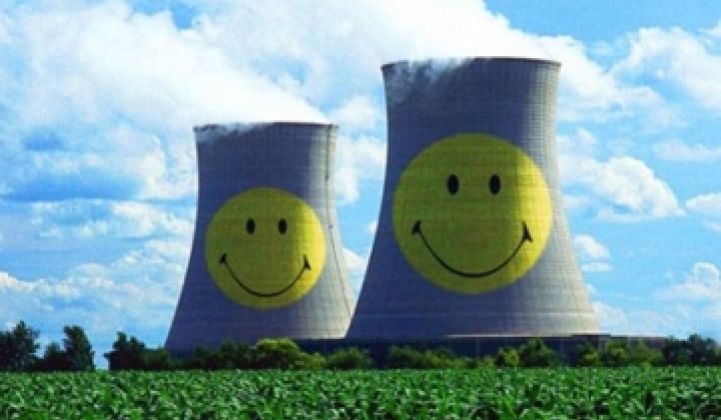Is it Green?
Is nuclear power green energy?
That's a question I've been asking nuclear industry folks and enviros for the last few years.
But I've come to realize it's the wrong question. It doesn't matter if it's green – nuclear is here to stay as a global energy source. In fact the Electrical Power Research Institute's prism study shows the U.S. obtaining 29 percent of its energy from nuclear sources in 2030, up from 21 percent today.
I guess the better questions are:
- How can we minimize the nuclear waste issue?
- How can we minimize the amount of water used for cooling?
- How can the US return to a leadership role in nuclear plant technology?
John Polcyn, the VP and Chief Nuclear Officer at Invensys knows nuclear. He has built and operated nuclear power plants while working at Bechtel – actually building nuclear plants on time and on budget (in China). And as you'd imagine – he's a supporter of the technology. "It is the lowest cost generation in the U.S., save for hydro," said Polcyn.
"The U.S. brought commercial nuclear power to the world. Now the world is bringing commercial nuclear power back to the U.S.," Polcyn said, adding, "If we don't build nuclear plants in the U.S. – we'll become a third-world country."
His company Invensys, has provided control and process systems to the nuclear industry for 50 years and he spoke at a renewable energy event this weekend sponsored and organized by law firm, Pillsbury.
Nuclear Past
The first commercial nuclear plant came on-line in the 1950s at Shippingport, Pa.– just outside of Pittsburgh. The U.S. has licensed several nuclear power plants since TMI – the last "new" one licensed was TVA's Watts Bar Unit 1 in 1996.
Nuclear Present
There are 104 operating nuclear reactors in the U.S. Many of those units are powered with nuclear fuel blended from Russian warheads. There are 439 commercial nuclear power units operating in 30 countries around the world. They generate 372 gigawatts – about 17 percent of global energy.
Nuclear Future
More than 40 new plants are being built in 13 countries. What's more, an additional 100 nuclear power units are planned with another 250 new units proposed.
There is increasing demand for nuclear in emerging countries with nuclear plants planned for desalination in the UAE. China is targeting a five-fold increase in nuclear capacity by 2020, India is targeting 20 to 30 new reactors by 2020 and the U.K. is building nine nuclear plants – the country wants to lessen its dependence on Russia for natural gas.
According to Polcyn, the U.S. is already building nuclear plants with one coming on-line in 2017. Civil work has begun at Southern Nuclear's Plant Vogtle site. He predicts that we'll be building and commissioning another eight plants in the next ten years.
Workforce Issues and an Aging U.S. Nuclear Fleet
For the rapidly aging U.S. fleet, obsolescence is starting to become an issue on operating nuclear power units. Most nuclear plants in the U.S. are more than 30 years old.
I hear from a lot of folks looking for work in the solar industry. I've yet to hear anybody ask me about a future in the nuclear industry. And that's a big problem for the field – the loss of intellectual capital through a graying workforce and the need to capture that "tribal knowledge."
Regarding the workforce "Mexico graduates more engineers than the U.S., I hope we catch up to Mexico," Polcyn said adding, "It's a global competition for resources. We've got to get into that game and win that battle."![]()
Environmental Concerns
"What we're talking about putting in Yucca Mountian has 95 percent of its energy left in it. We need to start reprocessing and closing that fuel cycle," said Polcyn.
Polcyn remarked that the size of Yucca Mountain was half the size of the hotel we were meeting in and that Yucca Mountain and nuclear waste disposal is "not a technology issue – its a political issue."
As for water, yes nuclear plants use lots of water – up to a million gallons a day. So do most energy generation technologies. And in some cases it's possible to use waste water.
Nuclear provides cheap baseload power. Yes, it has a high up-front cost (in the neighborhood of $3,000 per kilowatt) and, yes, it goes over budget and yes it takes too long to permit and build.
New technologies are emerging and "small nuclear" is being discussed very seriously (see Michael Kanellos' Guide to New Nuclear). VCs are seeking out opportunities in this new twist on nuclear power production. Here's a recent VC investment in new nuclear (in this case, fusion, not fission):

I still have a knee-jerk negative response to nuclear. But I don't see us having an alternative – domestically or globally.



